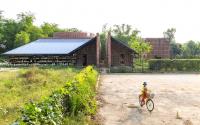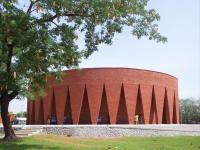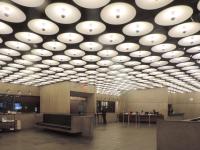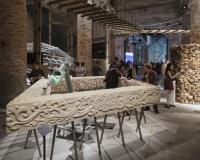Big Air in Beijing
Beijing, China
The XXIV Winter Olympics will take place in China in February 2022. The various sporting competitions will be held at a location in Beijing and in Yanqing and Zhangjiakou, located 75 km and 100 km northwest of the capital. While snowboarding has been an Olympic discipline since 1998, the big air freestyle event was added in 2018. As a result, this is only the second time Olympic-level big air competitions will take place in China.
In Beijing, the facilities built for the 2008 Summer Olympics were sufficient to accommodate most of the Winter competitions. Only one new building was required; a facility for free-style skiing and big air snowboarding. This was designed by Brian Li Zhang's Beijing office TeamMinus for a spectacular location in the Shougang Industrial Park within what was once the largest steelworks in the Beijing region. The creation of the new Olympic Games facility was employed to redesign the gigantic industrial relics for new purposes.
This is the most ambitious industrial heritage transformation project in Northern China. It aims to return civil life to this hundred-year-old steel mill, to reconnect the city with the Yongding River, and to replenish the deteriorated natural environment. The plan of Big Air Shougang combines the Winter Games venue with the transformation of a key part of the former steel plant centred around cooling towers, an oxygen generation plant and a cooling lake.
Inspired by the representation of the Buddhist apsaras in Dunhuang – female figures comparable to the nymphs of Greek and Roman mythology – the architects designed a complex adjacent to the preserved cooling towers at the edge the former cooling lake – named Qunming Lake. The apsaras, always flying at windy heights, with their waving scarves, are analogous to the elegant flight figures of the athletes in competition.
A series of newly designed open spaces connect a park landscape with the nearby river that, together with the spectacular scenery of the industrial relics, not only provides a background for the sporting events but will also be retained as an amenity for the residents of the capital.
In addition to the new free-standing ski jumping facility (Big Air Venue), TeamMinus renovated some of existing structures both for use during the Games and for specific uses afterwards. For example, the former oxygen plant which will be made available to start-ups. The transformation of the formerly gigantic steelworks into a park landscape with jobs for a sustainable economy shows the ambition of this project.
The centre piece of the redesign is the jump runway for the Big Air event. This standalone triangular structure consists of a lift, the in-run and take-off slopes and the landing area. It uses 3,000 tons of prefabricated steel components, 700 pieces of perforated aluminium panels and integrated retractable broadcast light poles. The stadium element comprises two parts. A permanent concrete-built lower part with 2,500 seats that is sunken into the lake, and an upper part of light steel above the water surface which will be removed after the Games in order to restore a more horizontal and continuous appearance to the waterfront.
With the implementation of the new sports facility in the old steelworks, TeamMinus demonstrates how a new urban landscape can be created through the adaptive reuse of industrial ruins in combination with new urban qualities. Since many other heavy industries will similarly fall out of use in China, the experience gained with this project is particularly important, as it shows that and how something new can emerge from the old.
From January 21st to March 10th 2022, the project will be shown in the exhibition Urban Ergonomics: From Steel Plant to Olympia to Public Good” at Aedes Architecture Gallery in Berlin.
Text and Review by Dr. Eduard Koegel
- Architects
- Atelier TeamMinus
- Location
- Beijing, China
- Year
- 2022
- Client
- Shougang Group Limited
- Team
- Lead Designer / Team: Zhang Li / Dou Guanglu / Bai Xue / Nicolas Godelet / Meng Fanxing / Michele Bonino, Profile Designer: Joe Fitzgerald / David Cerato, Architects: TeamMinus at Tsinghua University















